 | | | Switch to: Europe, USA, New Zealand, Antarctica Credit: NOAA/Ovation  Planetary K-index Planetary K-index
Now: Kp= 2.33 quiet
24-hr max: Kp= 2.33 quiet
explanation | more data
Interplanetary Mag. Field
Btotal: 4.46 nT
Bz: -1.24 nT south
more data: ACE, DSCOVR
Updated: Today at 1146 UT  Coronal Holes: 18 Feb 23 Coronal Holes: 18 Feb 23 
There are no significant coronal holes on the Earthside of the sun. Credit: SDO/AIA  Noctilucent Clouds Noctilucent Clouds
The southern hemisphere season for noctilucent clouds has begun. NASA's AIM spacecraft detected the first electric-blue puffs over Antarctica on Dec. 1st. Switch view:Ross Ice Shelf, Antarctic Peninsula, East Antarctica, Polar Updated Feb17  SPACE WEATHER
NOAA Forecasts | | Updated at: 2023 Feb 18 2200 UTC FLARE | 0-24 hr | 24-48 hr | CLASS M | 50 % | 50 % | CLASS X | 15 % | 15 % |  Geomagnetic Storms: Geomagnetic Storms:
Probabilities for significant disturbances in Earth's magnetic field are given for three activity levels: active, minor storm, severe storm Updated at: 2023 Feb 18 2200 UTC Mid-latitudes | 0-24 hr | 24-48 hr | ACTIVE | 30 % | 40 % | MINOR | 15 % | 30 % | SEVERE | 05 % | 10 % | High latitudes | 0-24 hr | 24-48 hr | ACTIVE | 10 % | 05 % | MINOR | 25 % | 20 % | SEVERE | 45 % | 70 % | | | |  | | | | | | | | | | | Never miss another geomagnetic storm. Sign up for Space Weather Alerts and you'll receive a text message when magnetic storms erupt. Aurora tour guides and professional astronomers use this service. You can, too! | | | GEOMAGNETIC STORM WATCH: Minor (G1) to moderate (G2) geomagnetic storms are possible this weekend in response to two incoming CMEs. One CME was hurled into space by a magnetic filament eruption on Feb 15th, the other by an X2.2-class solar flare on Feb. 17th. Both storm clouds are expected to deliver glancing blows, mitigating their impact. Aurora alerts: SMS Text. STRONG X2-CLASS SOLAR FLARE: Sunspot AR3229 erupted on Feb. 17th (2016 UT), producing a strong X2.2-class solar flare. NASA's Solar Dynamics Observatory (SDO) recorded the extreme ultraviolet pulse: 
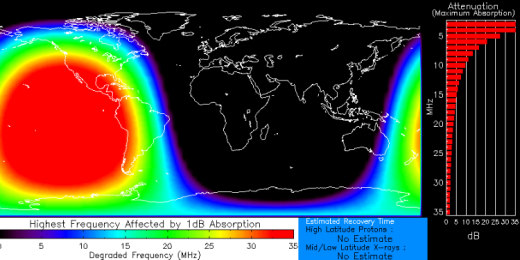
Ultraviolet and X-radiation ionized the top of Earth's atmosphere, causing a deep shortwave radio blackout over the Americas. Mariners, aviators and ham radio operators may have noticed loss of signal and other unusual propagation efftects at frequencies below 30 MHz for more than an hour after the flare. Solar flare alerts: SMS Text. SOLAR RADIO BURST: Amateur radio astronomer Thomas Ashcraft of New Mexico did not expect an X-flare yesterday, but he was perfectly positioned to observe it. "The sun was right in my radio telescope beam when the flare occured, and my spectrograph captured the full force of the resulting radio burst," says Ashcraft. Listen to the roar of static that emerged from his loudspeaker: 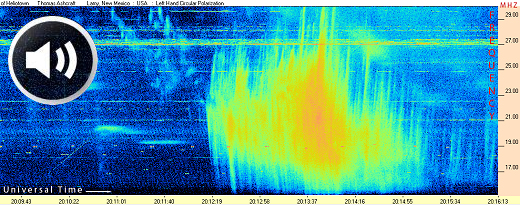
Click to listen, then take a look at the complete dynamic spectrum
This is a Type II solar radio burst. Shock waves from the flare rippled through the sun's atmosphere, creating plasma oscillations that emit shortwave energy. Briefly, the sun turned itself into a natural radio transmitter. Would you like to record an event like this? NASA's Radio JOVE program makes it easy. Off-the-shelf radio telescope kits allow even novices to monitor radio outbursts from the sun, which are becoming more frequent as Solar Cycle 25 intensifies. Realtime Space Weather Photo Gallery
Free: Spaceweather.com Newsletter THE INFINITY PEARL: Nothing says "I love you forever" like the Infinity Pearl. The students of Earth to Sky Calculus launched this unique pendant to the stratosphere onboard a cosmic ray research balloon. For more than 2 hours it floated 101,378+ feet above the Sierra Nevada mountains of central California:
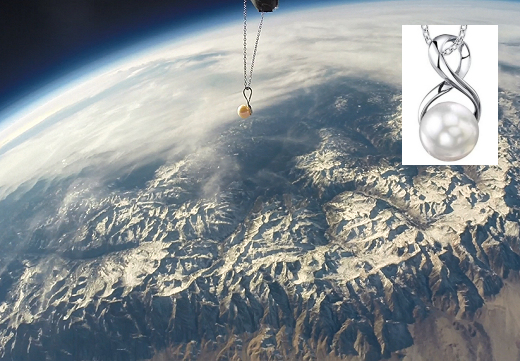
You can have it for $199.95. The students are selling space pearls to support their cosmic ray ballooning program. Measuring 9 mm in diameter, the Infinity Pearl is mounted on a sterling silver infinity twist and suspended from a matching 17 inch long sterling silver chain. Each one comes with a greeting card showing the pendant in flight and telling the story of its journey to the edge of space. Far Out Gifts: Earth to Sky Store
All sales support hands-on STEM education
Realtime Aurora Photo Gallery
Free: Spaceweather.com Newsletter Every night, a network of NASA all-sky cameras scans the skies above the United States for meteoritic fireballs. Automated software maintained by NASA's Meteoroid Environment Office calculates their orbits, velocity, penetration depth in Earth's atmosphere and many other characteristics. Daily results are presented here on Spaceweather.com. On Feb 18 2023, the network reported 6 fireballs.
(6 sporadics) 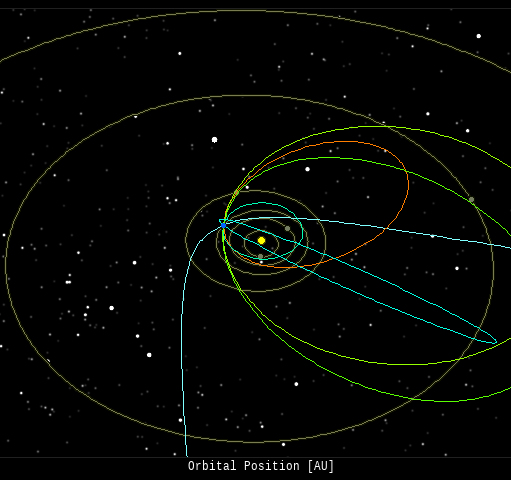 In this diagram of the inner solar system, all of the fireball orbits intersect at a single point--Earth. The orbits are color-coded by velocity, from slow (red) to fast (blue). [Larger image] [movies] Potentially Hazardous Asteroids ( PHAs) are space rocks larger than approximately 100m that can come closer to Earth than 0.05 AU. None of the known PHAs is on a collision course with our planet, although astronomers are finding new ones all the time. On February 18, 2023 there were 2330 potentially hazardous asteroids.
 | Recent & Upcoming Earth-asteroid encounters: | Asteroid | Date(UT) | Miss Distance | Velocity (km/s) | Diameter (m) | | 2023 CJ1 | 2023-Feb-13 | 12.5 LD | 7.2 | 28 | | 2023 CB3 | 2023-Feb-13 | 11.9 LD | 6.9 | 16 | | 2021 EP4 | 2023-Feb-13 | 19 LD | 6.1 | 5 | | 2023 CU1 | 2023-Feb-14 | 5.7 LD | 8.6 | 15 | | 2023 DB | 2023-Feb-14 | 6.8 LD | 3.6 | 16 | | 2023 CH2 | 2023-Feb-14 | 1.1 LD | 10.1 | 19 | | 2023 CP | 2023-Feb-14 | 17.2 LD | 3.4 | 36 | | 2023 CZ1 | 2023-Feb-14 | 17.7 LD | 8.6 | 15 | | 2023 CP2 | 2023-Feb-14 | 2.9 LD | 5.1 | 9 | | 2023 CN2 | 2023-Feb-15 | 4.6 LD | 9.7 | 10 | | 2023 CT1 | 2023-Feb-15 | 2.2 LD | 16.9 | 17 | | 199145 | 2023-Feb-16 | 12 LD | 24.6 | 770 | | 2023 CF2 | 2023-Feb-16 | 3.9 LD | 7.9 | 8 | | 2023 CV1 | 2023-Feb-16 | 10.6 LD | 7.3 | 36 | | 2023 CJ2 | 2023-Feb-16 | 6.8 LD | 8.2 | 29 | | 2022 RG | 2023-Feb-16 | 8.2 LD | 3 | 25 | | 2023 CG2 | 2023-Feb-16 | 1.3 LD | 21.3 | 14 | | 2023 CA3 | 2023-Feb-17 | 5.9 LD | 12.4 | 14 | | 2023 CS3 | 2023-Feb-17 | 9.4 LD | 4.7 | 15 | | 2023 CY1 | 2023-Feb-17 | 4.6 LD | 6.7 | 20 | | 2023 CW2 | 2023-Feb-17 | 1.6 LD | 2.3 | 4 | | 2020 DG4 | 2023-Feb-17 | 1.4 LD | 6.9 | 8 | | 2023 CC1 | 2023-Feb-18 | 15 LD | 12.2 | 41 | | 2023 CS2 | 2023-Feb-18 | 4.3 LD | 7.6 | 9 | | 2023 CE2 | 2023-Feb-18 | 13.6 LD | 16.1 | 28 | | 2023 CH1 | 2023-Feb-18 | 7.6 LD | 7.5 | 16 | | 2023 CW | 2023-Feb-18 | 6.7 LD | 7.6 | 26 | | 2020 CX1 | 2023-Feb-19 | 17.4 LD | 7.7 | 53 | | 2023 CR2 | 2023-Feb-20 | 19.3 LD | 17.4 | 21 | | 37638 | 2023-Feb-21 | 17 LD | 11.1 | 493 | | 2023 AA2 | 2023-Feb-22 | 17.4 LD | 10.1 | 133 | | 2023 CM2 | 2023-Feb-22 | 2.1 LD | 11.2 | 21 | | 2023 CS1 | 2023-Feb-23 | 15.1 LD | 9.1 | 30 | | 2023 CG1 | 2023-Feb-25 | 15.2 LD | 6.5 | 32 | | 2023 DA | 2023-Feb-26 | 2.8 LD | 5.9 | 18 | | 2023 CX2 | 2023-Feb-27 | 7.6 LD | 2.3 | 11 | | 2023 CC2 | 2023-Feb-27 | 16.2 LD | 5.1 | 32 | | 2012 DK31 | 2023-Feb-27 | 12.6 LD | 15.5 | 143 | | 2006 BE55 | 2023-Feb-28 | 9.4 LD | 13.3 | 145 | | 2021 QW | 2023-Mar-03 | 13.9 LD | 12.1 | 79 | | 2017 BM123 | 2023-Mar-03 | 12.1 LD | 7.8 | 61 | | 2007 ED125 | 2023-Mar-03 | 11.7 LD | 13.1 | 224 | | 2015 EG | 2023-Mar-04 | 13.9 LD | 10.6 | 27 | | 2023 BK5 | 2023-Mar-05 | 17.8 LD | 8.4 | 62 | | 535844 | 2023-Mar-07 | 10.5 LD | 7.7 | 149 | | 2020 FQ | 2023-Mar-09 | 14 LD | 6.3 | 13 | | 2020 FV4 | 2023-Mar-13 | 17.6 LD | 8.2 | 30 | | 2023 CM | 2023-Mar-14 | 10.3 LD | 14 | 190 | | 2018 UQ1 | 2023-Mar-17 | 10.7 LD | 11.7 | 143 | | 2016 WH | 2023-Mar-19 | 18.1 LD | 11.8 | 14 | | 2018 FE3 | 2023-Mar-21 | 10.1 LD | 5.4 | 13 | | 2022 YK4 | 2023-Mar-29 | 11.9 LD | 2.3 | 25 | | 2017 SE12 | 2023-Mar-30 | 5.2 LD | 8.4 | 15 | | 2016 GH1 | 2023-Mar-30 | 7.7 LD | 5.8 | 11 | | 2022 GO3 | 2023-Apr-02 | 17 LD | 11.6 | 15 | | 2021 GN1 | 2023-Apr-02 | 17.7 LD | 14.2 | 18 | | 2018 FD | 2023-Apr-07 | 17.9 LD | 8.2 | 47 | | 2019 GK21 | 2023-Apr-13 | 15.2 LD | 8.1 | 27 | | 2022 YK9 | 2023-Apr-13 | 19.9 LD | 9.9 | 175 | | 436774 | 2023-Apr-13 | 12.5 LD | 17.6 | 719 | Notes: LD means "Lunar Distance." 1 LD = 384,401 km, the distance between Earth and the Moon. 1 LD also equals 0.00256 AU. | | Cosmic Rays in the Atmosphere | SPACE WEATHER BALLOON DATA: Almost once a week, Spaceweather.com and the students of Earth to Sky Calculus fly space weather balloons to the stratosphere over California. These balloons are equipped with sensors that detect secondary cosmic rays, a form of radiation from space that can penetrate all the way down to Earth's surface. Our monitoring program has been underway without interruption for 7 years, resulting in a unique dataset of in situ atmospheric measurements. Latest results (July 2022): Atmospheric radiation is decreasing in 2022. Our latest measurements in July 2022 registered a 6-year low: 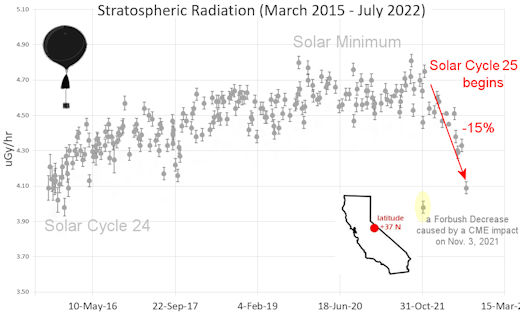
What's going on? Ironically, the radiation drop is caused by increasing solar activity. Solar Cycle 25 has roared to life faster than forecasters expected. The sun's strengthening and increasingly tangled magnetic field repels cosmic rays from deep space. In addition, solar coronal mass ejections (CMEs) sweep aside cosmic rays, causing sharp reductions called "Forbush Decreases." The two effects blend together to bring daily radiation levels down. .Who cares? Cosmic rays are a surprisingly "down to Earth" form of space weather. They can alter the chemistry of the atmosphere, trigger lightning, and penetrate commercial airplanes. According to a study from the Harvard T.H. Chan school of public health, crews of aircraft have higher rates of cancer than the general population. The researchers listed cosmic rays, irregular sleep habits, and chemical contaminants as leading risk factors. A number of controversial studies (#1, #2, #3, #4) go even further, linking cosmic rays with cardiac arrhythmias and sudden cardiac death. Technical notes: The radiation sensors onboard our helium balloons detect X-rays and gamma-rays in the energy range 10 keV to 20 MeV. These energies span the range of medical X-ray machines and airport security scanners. Data points in the graph labeled "Stratospheric Radiation" correspond to the peak of the Regener-Pfotzer maximum, which lies about 67,000 feet above central California. When cosmic rays crash into Earth's atmosphere, they produce a spray of secondary particles that is most intense at the entrance to the stratosphere. Physicists Eric Regener and Georg Pfotzer discovered the maximum using balloons in the 1930s and it is what we are measuring today. | | The official U.S. government space weather bureau | | | The first place to look for information about sundogs, pillars, rainbows and related phenomena. | | | Researchers call it a "Hubble for the sun." SDO is the most advanced solar observatory ever. | | | 3D views of the sun from NASA's Solar and Terrestrial Relations Observatory | | | Realtime and archival images of the Sun from SOHO. | | | information about sunspots based on the latest NOAA/USAF Active Region Summary | | | current counts of failed and deployed Starlink satellites from Jonathan's Space Page | | | Authoritative predictions of space junk and satellite re-entries | | | from the NOAA Space Environment Center | | | fun to read, but should be taken with a grain of salt! Forecasts looking ahead more than a few days are often wrong. | | | from the NOAA Space Environment Center | | | the underlying science of space weather |  | BestCSGOGambling is the best site for everything related to CSGO gambling on the web |  | To find reviews of new online casino sites in the UK try The Casino DB where there are hundreds of online casino reviews complete with bonuses and ratings. Alternatively, Online-Casinos.xyz is another massive directory of online casinos listing sites for the UK and Worldwide. Casinos that offer Rupees for bonuses are very generous to Indian players. Find the best online casinos in India at AllCasinos.in Looking for a new online casino? Try Casimpo the new site dedicated to making online casino simple, or check out the new Avenger Slots Casino and Ace Online Casino with over 500 online slots and casino games. |  | When looking for casinos to play online when the weather is bad, you can try casino online trucchi for Italian games. If you are not from Finland you can try the Swedish page Svenska casino online to find suitable games, check out svenskacasinoonline.net. Always check your local laws before playing with real money. |  | Looking for sports betting companies not registered on GamStop? CasinoGap has presented a list of sites not on GamStop available for UK players. Check and bet online! Would you like to bet at sites not using GamStop? Look at a list of NonStopCasino sites for online betting that aren't on GamStop. Top-rated bookmakers ever! | | | These links help Spaceweather.com stay online. Thank you to our supporters! | | | | | | | | |  | |  |   | ©2021 Spaceweather.com. All rights reserved. This site is penned daily by Dr. Tony Phillips. | |

